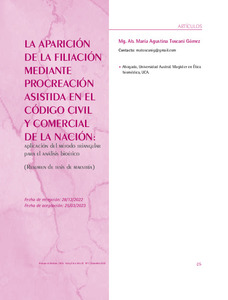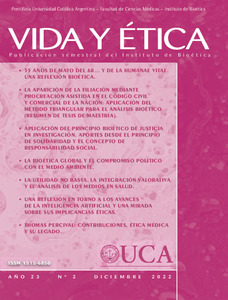Por favor, use este identificador para citar o enlazar este ítem:
https://repositorio.uca.edu.ar/handle/123456789/16455| Campo DC | Valor | Lengua/Idioma |
|---|---|---|
| dc.contributor.author | Toscani Gómez, María Agustina | es |
| dc.date.accessioned | 2023-06-01T13:10:21Z | - |
| dc.date.available | 2023-06-01T13:10:21Z | - |
| dc.date.issued | 2022 | - |
| dc.identifier.citation | Toscani Gómez, M. A. La aparición de la filiación mediante procreación asistida en el Código Civil y Comercial de la Nación: aplicación del método triangular para el análisis bioético [en línea]. Vida y Etica. 2022, 23 (1). Disponible en: https://repositorio.uca.edu.ar/handle/123456789/16455 | es |
| dc.identifier.issn | 1515-6850 (impreso) | - |
| dc.identifier.issn | 2683-6998 (online) | - |
| dc.identifier.uri | https://repositorio.uca.edu.ar/handle/123456789/16455 | - |
| dc.description.abstract | Resumen: En este trabajo se realiza un juicio bioético sobre la filiación por procreación artificial establecida en el Código Civil y Comercial de la Nación, aplicando el método triangular propuesto por Sgreccia para análisis bioético. El mismo comienza examinando el dato fáctico, en este caso, la norma jurídica, y luego se observan los valores antropológicos comprometidos. Así, se concluye que la filiación mediante técnicas de reproducción asistida parte de una errada concepción del ser humano, vulnera valores como la verdad, la vida y la dignidad, y no respeta ninguno de los cuatro principios jerarquizados del Personalismo ontológico, debiendo considerarse bioéticamente ilícita. También se comprueba que compromete derechos humanos fundamentales, afectando la coherencia del sistema jurídico argentino y del mismo Código. Se concluye con una serie de propuestas para promover la cultura de la vida y de los derechos humanos en la que no se descarte a ningún miembro de la familia humana. | es |
| dc.description.abstract | Abstract: In this paper a bioethical judgment is made on filiation by artificial procreation established in the Civil and Commercial Code of the Nation, applying the triangular method proposed by SGRECCIA for bioethical analysis. It begins by examining the factual data, in this case, the legal norm, and then the anthropological values involved are observed. Thus, it is concluded that filiation by means of assisted reproduction techniques is based on an erroneous conception of the human being, violates values such as truth, life and dignity, and does not respect any of the four hierarchical principles of ontological Personalism, and must be considered bioethically illicit. It is also proven that it compromises fundamental human rights, affecting the coherence of the Argentine legal system and of the Code itself. It concludes with a series of proposals to promote the culture of life and human rights in which no member of the human family is discarded. | es |
| dc.format | application/pdf | es |
| dc.language.iso | spa | es |
| dc.publisher | Educa | es |
| dc.rights | Acceso abierto | * |
| dc.rights.uri | http://creativecommons.org/licenses/by-nc-sa/4.0/ | * |
| dc.source | Vida y Etica Año 23, No.2, 2022 | es |
| dc.subject | DERECHOS DEL NIÑO | es |
| dc.subject | PERSONALISMO ONTOLÓGICO | es |
| dc.subject | PROCREACION ARTIFICIAL | es |
| dc.subject | DERECHO DE FAMILIA | es |
| dc.subject | REPRODUCCION HUMANA ASISTIDA | es |
| dc.subject | FILIACION | es |
| dc.title | La aparición de la filiación mediante procreación asistida en el Código Civil y Comercial de la Nación: aplicación del método triangular para el análisis bioético | es |
| dc.type | Artículo | es |
| uca.disciplina | BIOETICA | es |
| uca.issnrd | 1 | es |
| uca.affiliation | Fil: Toscani Gómez, María Agustina. Universidad Austral; Argentina | es |
| uca.affiliation | Fil: Toscani Gómez, María Agustina. Pontificia Universidad Católica Argentina; Argentina | es |
| uca.version | publishedVersion | es |
| item.grantfulltext | open | - |
| item.languageiso639-1 | es | - |
| item.fulltext | With Fulltext | - |
| Aparece en las colecciones: | VE - 2022 Año 23 nro. 2 | |
Ficheros en este ítem:
| Fichero | Descripción | Tamaño | Formato | |
|---|---|---|---|---|
| aparición-filiación-mediante-procreación.pdf | 366,55 kB | Adobe PDF |  Visualizar/Abrir | |
| vidayetica2022-2-portada.pdf | 114,68 kB | Adobe PDF |  Visualizar/Abrir |
Visualizaciones de página(s)
111
comprobado en 27-abr-2024
Descarga(s)
88
comprobado en 27-abr-2024
Google ScholarTM
Ver en Google Scholar
Este ítem está sujeto a una Licencia Creative Commons

